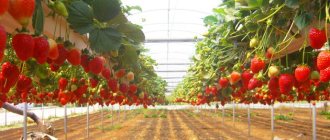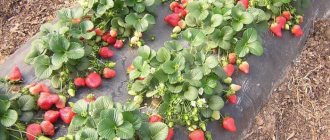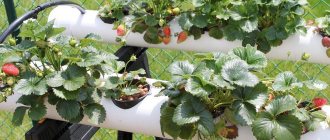Strawberries are a popular berry that is loved not only in our country, but throughout the world. Strawberries are consumed both fresh and used in processing to make jam, jam, juices, etc. With the appearance of the first harvests in the spring, the berries are literally sold out. And sometimes it doesn’t matter what the price tag is. A kilogram of early strawberries in large cities costs at least 250 rubles...
You can start your own mini-business growing strawberries even from a summer cottage. To sell the first batches of berries, no documents are needed, since the products are sold from personal plots. Registration of individual entrepreneurs, tax deductions, all this later, when industrial scale appears. At first, berries can be sold through fruit shops and kiosks, as well as by handing over berries in small wholesale quantities to resellers. Do you want to learn more about business and earn stable money? We offer you a new free marathon about passive income and wise investment of money .
By choosing the method that interests you, you can earn a good income while doing something clear.
Growing strawberries
Depending on production capacity and economic opportunities, different methods of growing strawberries are chosen. Dutch technology is very popular. How it works? Industrial cultivation of strawberries is carried out through continuous planting of seedlings throughout the year, regardless of the season. After a month or a month and a half, when the harvest is over, the plants are thrown away and new ones are planted in their place.
In order for strawberries to bear fruit quickly, the plant bushes receive special nutrition, which is supplied to them through pipelines. The drip method of liquid supply is used.
Following this technology, plants in a greenhouse can be placed vertically in pots or horizontally on racks. For comfortable growth, they need to be provided with decent maintenance:
- Normal lighting. If it is not enough, additional light sources are installed. Approximate calculation: for six square meters of area you need only one sixty-watt light bulb. If you increase the daylight hours to twelve to sixteen hours, the strawberries will bloom in ten days.
- Watering using a drip system. It must be carried out regularly and consistently.
- The optimal humidity in a greenhouse is no higher than eighty degrees. This is achieved through regular overhead watering. The procedures are stopped during the flowering period, since water entering the vegetative part of the plants leads to fungal diseases.
- If the greenhouse does not have a ventilation system, the room must be ventilated. Carbon dioxide levels are monitored by special sensors.
- It is necessary to constantly maintain the temperature. Eighteen to twenty-one degrees are enough before flowering begins, and twenty-eight when the first flowers appear.
- If necessary, artificial pollination of plants is carried out.
Planting strawberries in a greenhouse is carried out in the same way as in open ground. Planting material is seedlings obtained by rooting mustaches and seedlings grown from seeds. Industrial cultivation of strawberries is carried out with seedlings purchased in specialized stores or nurseries.
People's reviews about the strawberry business
Anna, 38 years old, Voronezh:
I have been growing strawberries for 2 years. My one greenhouse brings in 600 thousand a year. I don’t work anywhere else and it’s enough for me. Plus there is a lot of free time and the children always have berries.
Igor, 41 years old, Volgograd:
I was thinking about how to make money from strawberries. I rented a plot, installed 5 greenhouses, hired people. I make 4 million profit a year.
Valentina, 22 years old, student, Izhevsk:
Half of my room is occupied by bags of strawberries. With their help I pay for my studies and live without working anywhere. I also make custom strawberry bouquets. I'm studying to be an agronomist. In the future I plan to scale the business.
In this article we looked at from A to Z how to make money on strawberries. All this is real and in Russia you can earn a good income this way. Harvesting is simple, caring for the bushes is simple. And if you buy especially fertile seedlings, for example, at 149 rubles per bush, then you can make a profit of 600 thousand rubles a year from the greenhouse alone.
Let's say without embellishment that resale of seedlings, sale of berries, chocolate-covered strawberries to order, bouquets of berries, and other sales of products have high profitability and quick self-sufficiency. Anyone can open and organize such a business from scratch. Suppliers of strawberries at affordable prices will never be left without attention.
Strawberry varieties for industrial cultivation
There are a huge variety of strawberry varieties and hybrids. But for industrial cultivation in greenhouse conditions in the Far East, Siberia and the Urals, remontant varieties are better suited. There is no need to create artificial pollination for them, since they are self-pollinated varieties. Remontant strawberries ripen early, which ensures a good harvest even when the bushes are dense.
This strawberry belongs to the group of day-neutral plants, so there is no need to install additional lighting in the greenhouse. There are many remontant varieties, some of them are presented below.
The problem of wintering strawberries
Almost throughout the entire territory of Russia, snowless winters and, as a result, freezing of plants are possible. Experienced gardeners have long practiced winter covering of strawberries with sawdust, spruce branches, straw and other materials. But with excess cover and large snow cover, heating is often observed, which negatively affects the future harvest.
In recent years, many farms and amateur gardeners have introduced the practice of covering plantations for the winter with white non-woven material (agrospan, spunbond) - with a density of 60 g/sq.m. Under such a canopy, strawberry plants overwinter well and do not get damaged.
- How to prepare strawberries for winter - all the most important autumn tasks
Caring for strawberries does not end with picking the berries - for a good harvest, you need to take care of the beds until late autumn.
Well-wintered plants produce a bountiful harvest. Moreover, in the early spring they begin to develop under a canopy made of non-woven material, and after removing the cover at the end of April - beginning of May they look quite strong, and later they bloom earlier and bear fruit well. For most European varieties, such shelter turns out to be a lifesaver, which compensates for their lack of winter hardiness.
But we have already determined in practice that for Californian varieties - Portola, San Andreas, Albion, Monterey, Selva - such shelter is insufficient. In spring and early summer, it is felt that plants of these varieties emerge weakened after winter. And, apparently, they require more thorough protection.
Nevertheless, the use of such shelter can be considered a revolutionary technology, since it provides consistently high-quality overwintering at relatively low labor and financial costs. In addition, it turned out that the use of such winter shelter, starting from the end of September - beginning of October, promotes better formation of flower buds, and therefore increases the next year's harvest.
Elsanta
This variety of strawberry is popular and is grown everywhere in open ground and in greenhouses. The value lies in the high quality of the berries and their attractive appearance. The fruits are well transported and stored for a long time without compromising quality, even at room temperature.
This is a dessert variety of Dutch selection. The berries are large in size and bright red in color with a shiny surface. They have a wide cone shape and amazing taste. The disadvantage of this variety is its susceptibility to fungal diseases and low frost resistance. In order for plants to survive until spring, they need to be covered for the winter.
Sales of products
Strawberries are in demand among buyers at all times of the year, and in winter this is not prevented even by a high trade margin. From this point of view, such a business is extremely profitable. Selling products at retail is quite expensive - investments will be required to organize a retail outlet. In addition, it is impossible to compete with supermarkets, where dozens of other fruits are sold along with strawberries.
Therefore, you should find wholesale customers who will buy the entire crop for subsequent retail sale or other use. This role can be played by:
- retail chains;
- catering establishments;
- producers of juices, jams, confitures and other berry products.
Honey
This strawberry variety has a high yield. If you plan to grow strawberries on an industrial scale, Honey is ideal for greenhouses and open ground, as it has good transportability. The berries of this variety are large, with thick skin and dark red color, have a piquant taste with sourness and a glossy shine on the surface. The harvest is harvested when the berries are fully ripe.
This strawberry variety is disease resistant. It is not afraid of temperature changes, heavy rains and frosts if grown outdoors. Strawberries grow even in soils with excessive calcium content.
Albion
When growing strawberries in industrial greenhouses for business, it is recommended to start with this remontant variety, which gardeners love. After all, this strawberry bears fruit for the longest time. The berries have excellent taste and excellent presentation. They are transported without loss of quality.
Large, elongated berries have an attractive cone shape. They are consumed fresh and processed: confitures, jams, and preserves are prepared. Strawberries are resistant to late blight, verticillium and other diseases. Tolerates adverse weather conditions.
Let's sum it up
Growing strawberries is a costly and labor-intensive process, which, with the right approach, can easily be turned into a permanent source of income. Despite the seasonality of fruiting, it is possible to create a greenhouse with year-round cultivation. This will require significant financial investments, 8 times more than when organizing a business in garden beds. The key success of business activity is well-established sales of products. To do this, you need to conclude agreements in advance with wholesale companies, grocery stores and market traders.
Portola
This variety of remontant strawberries from America is new. But it has managed to prove itself in the best possible way, especially for those who plan to start industrially growing strawberries in a greenhouse all year round. Portola is a continuation of a variety with a good reputation - Albion. But the new variety has a yield higher than its predecessor by thirty percent.
The berries are very large, heavy, their weight reaches thirty grams or more. They are distinguished by their expressive shape, in the form of a wide cone. The flesh is firm, without crunch. Very pleasant, harmonious taste.
The disadvantage of the variety is its weak resistance against diseases such as brown spot. Therefore, preventive treatments with fungicides, such as Quadris, should be carried out regularly.
Industrial greenhouses
In order to obtain tasty and healthy berries for a long time, they are grown in greenhouses, which are of two types:
- Seasonal. They are more popular because their construction requires little investment. In such greenhouses, cultivated plants of vegetable gardens and gardens are grown from March to November, that is, until the time when the premises are not required to be heated.
- Year-round. The construction of such greenhouses requires large investments. This is due to the construction of equipment rooms. Such buildings are highly profitable, since vegetables and fruits are grown in them all year round.
Greenhouses for growing strawberries on an industrial scale differ in many other ways. Thus, glass covering is used for seasonal greenhouses, since its installation requires a durable frame.
Polycarbonate has gained great popularity as a covering material. It is easy to install, has great strength, high thermal insulation properties and transmits light well. It withstands temperature changes and is easily transported without being deformed.
Beds in greenhouses are arranged in the ground, on racks (horizontally) or in hanging bags (vertically). The frame of greenhouses can be wooden, metal or polymer. The choice of greenhouse depends, first of all, on financial capabilities and production space.
Profitability
Business income from growing and wholesale strawberries will be high if the entrepreneur finds permanent sales channels. The wholesale price for 1 kg greatly depends on the manufacturer and varies from 45 to 400 rubles. Most often, manufacturers set a minimum purchase volume - for example, from 50 kg.
The profitability of the project directly depends on the initial investment. The business plan will include expenses for:
- purchase or lease of land;
- installation of greenhouses;
- purchase of soil, seedlings;
- utilities (electricity, water or gas for greenhouses);
- purchase of working equipment, containers, bags and everything necessary for growing;
- packaging containers;
- recruitment of personnel.
The amount of costs depends on the chosen technology: open ground will be the most inexpensive and unprofitable, the Dutch method will be the most expensive and promising in terms of income. Payback on all investments is possible in 20–25 harvests , but most likely it will take even longer.
Strawberries in open ground
Industrial cultivation of strawberries in open ground is simple and has good economic benefits. This is achieved due to the fact that strawberries grow on soils with different granulometric compositions.
To ensure high yields, the soil is filled with fertilizers, green manure and perennial grasses. Dry areas, damp areas with a lot of stagnant water and marshy areas are unsuitable for growing strawberries. Surface occurrence of groundwater is undesirable.
Industrial cultivation of strawberries is carried out on flat areas or gentle slopes. If you place it in low places, it may suffer from frost. There should be a natural or artificial reservoir near the site.
The beds with strawberries are surrounded on all sides by tree plantations. They are planted in blocks of 4x10 hectares, which are separated by internal roads three to four meters wide. Rows for planting strawberries must be at least one hundred meters wide.
Crop rotations
Industrial cultivation of strawberries involves such agrotechnical measures as designing crop rotations. Growing in one place, strawberries produce high yields for three to four years. Then it weakly resists frost, is more often affected by diseases, and its berries become smaller. As a result, productivity decreases.
The crop rotation of each farm is made taking into account production conditions and economic opportunities. An example of seven-field crop rotation for the Black Earth regions of Russia:
- Strawberries are planted in the first field.
- On the second, third, fourth, fruit-bearing strawberries grow and produce good harvests.
- In the fifth plot, where strawberries grew, oats or rye are planted to prepare green mass for livestock feed.
- At the sixth site, a vetch-oat mixture is being planted, from which feed is prepared for livestock.
- The seventh plot is left fallow and nothing is planted on it.
About mulching
Mulching strawberries with film is used to obtain early and high yields. The best film for mulching is black opaque polyethylene; it can last up to 4 years.
When mulching, the soil in the rows is not loosened, but in the first year of fruiting, 1.2 weedings are carried out (near the holes where the plants are planted) and 3.4 loosening of the rows.
A substitute for polymer film is cheap (5.6 times cheaper than film) special thermohydrophobic paper, which, after the end of the strawberry’s life, decomposes without clogging the soil.
How to prepare the soil?
Before planting strawberries, in open ground or a greenhouse, the soil is plowed to a depth of forty centimeters or a little less. Then its surface is leveled with a harrow, first in one direction, then in the other, and at the end of the process - across the rows.
The next step is the application of manure. Per square meter of chernozem soil - thirty to forty tons, podzolic soil - eighty to one hundred for the same area. About a couple of years before the planned planting of strawberries in a new place, one field participating in crop rotation is selected, and from three to six tons of lime fertilizers per hectare are applied to its soil.
Planting strawberries
The technology for industrial cultivation of strawberries can be different, but most often they use a single-row planting method. Plants are planted in rows, the distance between them is seventy to ninety centimeters, and between seedlings - fifteen to thirty.
If strawberries are grown using mulch film (in open ground), planting is done in a two-row manner. The distance between the rows is eighty-five centimeters. But in one row, strawberries are planted in two ribbons, the distance between them is thirty-five centimeters, and between the plants in each ribbon is fifteen.
The planting pattern is directly related to the period of use of strawberry bushes. If a crop will not grow in one field for long, the plants should be planted densely, as with the Dutch technology in a greenhouse.
The optimal timing for planting in open ground conditions is considered to be late summer - early autumn and early spring. But it is still better to plant strawberries in early autumn. This time is characterized by abundant precipitation, which is a favorable condition for good survival of seedlings. For areas where there is little snowfall, it is not recommended to plant strawberries in the fall, as the plants do not have time to get stronger and may freeze.
Strawberries are planted on an industrial scale on large plantations with special machines called transplanters (types of units - SKN-6, SKNB-4A and others). If it is not possible to use machine labor, manual labor is used. But first they water and mark with a Belarus tractor with a cultivator attached to it.
These terms do not apply to strawberries growing in a greenhouse. Thus, following Dutch technology, seedlings are planted every month and a half, regardless of the time of year.
A sea of pleasure and health
Strawberries perfectly quench thirst, improve digestion, and stimulate appetite. They amazingly combine many health-promoting qualities that regulate metabolism, improve blood composition, and have anti-sclerotic, diuretic, diaphoretic, hemostatic and astringent effects.
Strawberries contain a huge amount of biologically active substances that can dilate blood vessels, increase the amplitude of heart contractions, lower blood pressure, normalize stomach function and have a positive effect on women's health. In terms of vitamin C content, strawberries are confidently ahead of citrus fruits, and they contain no less calcium than apples.
Strawberries are at the same time a delicacy, a storehouse of vitamins and a favorite treat for children and adults. Every spring, with the beginning of the short strawberry season, people rush to enjoy this delicacy for the whole year ahead.
But is there a real chance to ensure that our favorite berries are always on our table: on New Year’s holidays, during the period of vitamin deficiency in March, and in early autumn? The answer to this question is being sought and already found by breeders, farmers, businessmen and even housewives who liked to grow sweet bright red strawberries on their windowsills instead of parsley and onions.











